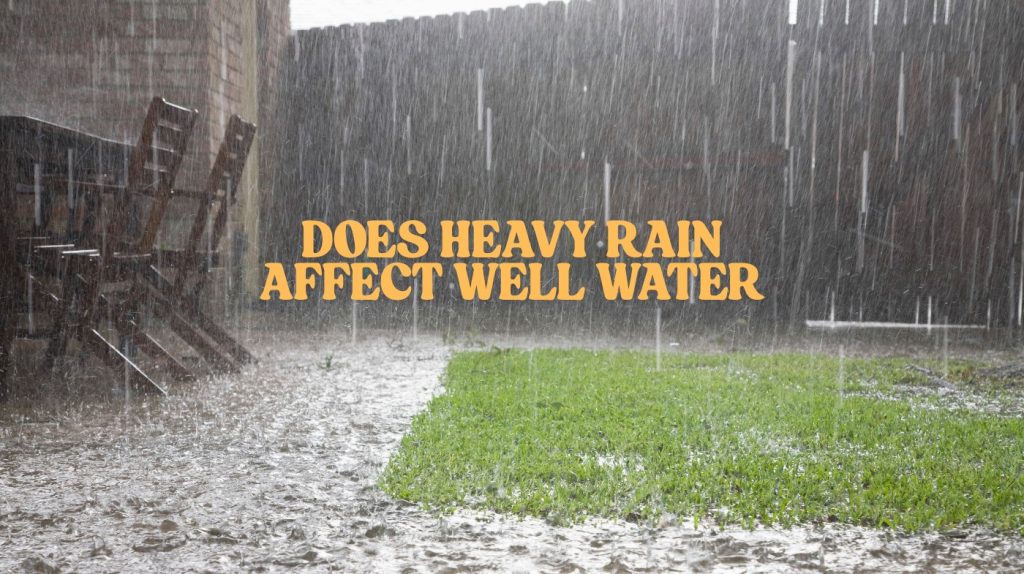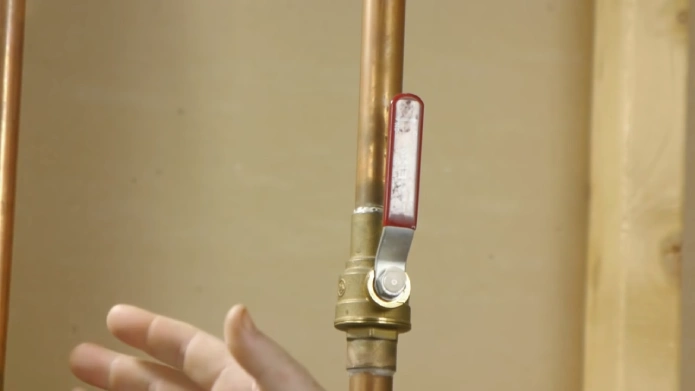Last Updated on June 9, 2025
Heavy rain can substantially affect your well water quality by increasing the risk of bacterial and chemical contamination. Floodwaters may infiltrate poorly sealed or damaged well casings, introducing harmful pathogens, nitrates, pesticides, and heavy metals into your water supply.
These contaminants pose serious health risks, especially after flooding events. Proper well construction, sealing, and regular inspections are vital to minimize these effects. Understanding these impacts helps you better protect your water source during intense rainfall.
Key Takeaways
- Heavy rain can cause flooding that allows bacteria and contaminants to enter wells through poorly sealed or damaged casings.
- Runoff from heavy rain transports chemicals, nitrates, and microbial pathogens into groundwater, degrading well water quality.
- Elevated nitrates from runoff pose health risks like methemoglobinemia, especially in infants, and boiling water does not remove nitrates.
- Structural damage to well casings during floods increases contamination risks, requiring regular inspection and maintenance.
- Heavy rain temporarily raises water tables but also introduces pollutants, making frequent water testing essential after storms.
How Heavy Rain Influences Well Water Quality?
When heavy rain causes flooding, it can submerge well casings, considerably increasing the risk of bacterial contamination and compromising structural integrity.
Floodwaters may infiltrate gaps or cracks in poorly sealed casings, allowing surface bacteria to enter the well. In some cases, this contamination includes coliform bacteria, which can cause gastrointestinal and flu-like symptoms.
Additionally, soil compaction from flooding alters the surrounding soil matrix, impacting groundwater flow and potentially reducing natural filtration. This compaction can increase the transport of contaminants toward the well.
Installing a mixing valve can help maintain consistent water temperature and reduce corrosion risks in affected plumbing systems. Structural damage caused by prolonged exposure to floodwater can weaken casing materials, necessitating prompt inspection and repair to maintain well safety.
To minimize risks, it’s essential to implement regular post-flood inspections and perform disinfection treatments when necessary. Understanding these mechanisms helps guarantee you maintain safe and reliable well water quality after heavy rainfall events.
Common Contaminants Introduced by Rainfall
Although heavy rainfall replenishes groundwater, it also introduces various contaminants into well water that can compromise its safety and quality.
Rainwater runoff transports microbial agents, chemicals, and sediments into your well, especially if construction is inadequate or the surrounding geology is vulnerable. Understanding the typical contaminants helps you assess risks and implement protective measures.
Raw sewage pumped into nearby rivers during heavy rains can increase the pathogen load in groundwater sources.
| Contaminant Type | Examples |
|---|---|
| Microbial | Bacteria (coliform), viruses, parasites (Giardia) |
| Chemical | Nitrates, heavy metals, pesticides, PFAS |
| Physical | Sediments from erosion and runoff |
| Environmental Factors | Karst geology, well integrity, surface activities |
Monitoring these contaminants after heavy rain is essential for maintaining well water safety. Regular testing is recommended especially after heavy rainfall events to detect increases in microbial contamination and chemical pollutants that may enter the well.
Health Risks Linked to Contaminated Well Water
You should recognize that pathogens like E. coli and Giardia can infiltrate well water after heavy rain, causing gastrointestinal illnesses. Nitrate contamination, often from agricultural runoff, poses acute risks such as methemoglobinemia, especially in infants.
Additionally, chemical pollutants from pesticides and industrial sources can lead to chronic health effects, including cancer and organ damage, underscoring the need for vigilant water testing. Using appropriate submersible pumps can help prevent contamination by efficiently managing water accumulation around wells.
Pathogens Causing Illness
How do pathogens in well water pose serious health risks? These microorganisms can lead to a significant burden of illness, hospitalizations, and even death. Contaminated well water often harbors bacteria such as Legionella, E. coli, and nontuberculous mycobacteria (NTM), all linked to severe diseases.
You should consider these critical impacts:
- Illness: Waterborne pathogens cause approximately 7.15 million illnesses annually in the U.S. Implementing a battery backup system can help maintain water safety by ensuring sump pump operation during power outages.
- Hospitalizations: Around 118,000 people require hospital care each year due to these infections.
- Mortality: Roughly 6,630 deaths occur annually from waterborne diseases linked to contaminated wells.
Heavy rainfall exacerbates these risks by increasing flooding and runoff, introducing pathogens into your well. After major flooding events, such as Hurricane Harvey, studies have shown a significant increase in microbial contamination in private wells, with total coliform and E. coli levels rising by 1.5 to 2.8 times.
Nitrate Exposure Concerns
Pathogens aren’t the only concern when it comes to well water quality, nitrate contamination presents significant health hazards that require careful attention. Nitrates often originate from fertilizers, animal waste, septic leaks, and sewage discharge, all of which heavy rain can exacerbate by increasing runoff and leaching into groundwater.
Additionally, improper sealing of entry points around wells can allow contaminants and pests to infiltrate the water supply, increasing health risks.
Elevated nitrate levels impair oxygen transport in the body, causing methemoglobinemia, especially dangerous for infants under six months, and are linked to birth defects, miscarriages, and potential cancer risks. The EPA limits nitrate concentrations to 10 mg/L in drinking water; exceeding this poses immediate health threats.
Since boiling water doesn’t remove nitrates, you must rely on regular testing, well inspections, and treatment systems to mitigate exposure. Testing your well water annually, especially if you plan a pregnancy or have infants, is essential to ensure safety. Understanding these risks enables you to manage your well’s nitrate contamination effectively.
Chemical Contaminant Effects
Although many well water contaminants are biological, chemical pollutants pose equally serious health risks that require vigilant monitoring. Heavy rain can exacerbate chemical contamination by introducing arsenic, heavy metals, pesticides, and organic compounds into your well through surface runoff and soil leaching.
These chemicals carry significant health risks you need to understand:
- Chronic exposure to arsenic and heavy metals can cause cancer, cardiovascular disease, neurological disorders, and reproductive issues. These contaminants often originate from household plumbing and industrial sources, which can be mobilized during heavy rain events.
- Pesticides and organic chemicals damage the liver, kidneys, and circulatory system, potentially elevating cancer and heart disease risks. Inspecting and maintaining your well system regularly helps prevent contamination and ensures proper function of crucial components like the pump motor.
- Radon gas presence in well water increases lung cancer risk upon inhalation or ingestion.
Seasonal and Long-Term Effects on Groundwater
When heavy rain falls, it directly influences groundwater levels by recharging aquifers and raising the water table, which can temporarily alter well water availability. You’ll notice seasonal fluctuations as increased precipitation elevates groundwater, improving supply after dry spells.
However, malfunctioning components like a shower mixing valve can also impact water pressure and flow in household systems connected to well water. Heavy rains also heighten surface runoff, introducing contaminants like nitrates, pathogens, and organic matter into recharge zones, which can degrade water quality.
This is because heavy rainstorms can negatively affect well water quality by introducing surface water. Over the long term, shifts in rainfall patterns due to climate variability affect recharge rates and pollutant loading, complicating groundwater chemistry and well water stability.
Episodic heavy rain events followed by droughts cause abrupt water quality changes, increasing contamination risks. Understanding these seasonal and long-term dynamics is essential for anticipating groundwater behavior and maintaining safe well water supplies amid evolving precipitation regimes.
Importance of Well Construction and Maintenance
You need to guarantee your well is properly sealed to prevent surface water and contaminants from entering, especially after heavy rain. Ensuring the casing extends at least 1 foot above ground and that the annular space is fully sealed with grout is essential for well integrity well construction.
Regular inspections help you detect structural issues and water quality changes early, reducing health risks and costly repairs. Prioritizing these steps maintains your well’s integrity and safeguards your water supply.
Additionally, installing a check valve in your water system can prevent backflow and protect your well pump from damage.
Well Sealing Importance
Since well sealing directly influences groundwater safety, you must prioritize proper construction and maintenance techniques. Effective sealing prevents surface water and contaminants from entering your well, especially after heavy rains.
To ensure this:
- Maintain casing integrity: Confirm casing is crack-free, extends above ground, and seals gaps to block infiltration.
- Use high-quality well caps: Install vermin-proof, vented caps that prevent debris and pests while allowing airflow.
- Engage licensed contractors: Hire certified professionals who follow regulatory codes and employ proven installation methods. Annual checkups by licensed or certified professionals help identify and address potential sealing defects early.
Proper sealing combined with strategic well siting and ongoing upkeep forms the foundation of a reliable groundwater supply resistant to heavy rainfall impacts.
Regular Inspection Benefits
Although well construction sets the foundation for water safety, regular inspections play a critical role in sustaining well performance and preventing contamination.
By visually inspecting your well annually, you can detect leaks, corrosion, or structural damage early, reducing contamination risk. Annual inspections also help identify leaks, loose connections, or frayed wires that may compromise well function.
Routine water testing for coliform and *E. coli* bacteria guarantees safe drinking water, while periodic pH and dissolved solids measurements monitor chemical changes impacting well longevity.
Monitoring the electrical components, including any extension cords used, ensures continued safe operation of submersible pumps. Monitoring flow rate helps identify yield reductions and sediment buildup, enabling timely rehabilitation.
Structural evaluations detect casing cracks and grout deterioration, preventing pollutant infiltration. Maintaining documentation of inspections, water quality, and repairs supports trend analysis and regulatory compliance.
Ultimately, consistent maintenance extends your well’s operational life, enhances pumping efficiency, and reduces costly repairs, ensuring a reliable, safe water supply despite environmental challenges like heavy rain.
Strategies to Protect Well Water After Heavy Rain
When heavy rain occurs, protecting your well water requires immediate and strategic actions focused on preventing contamination and maintaining system integrity.
Start by ensuring the well casing extends at least one foot above ground and that the cap is securely sealed to block surface water. Maintaining proper site management such as ensuring ground slopes away from the well casing is essential to prevent water pooling near the well.
Adjusting the discharge valve can also help control water flow around the well area to reduce infiltration risks. Ensure your well casing rises at least one foot above ground with a tightly sealed cap to prevent surface water entry.
Next, manage stormwater runoff by grading the land to slope away from the well and directing gutters and drains accordingly. Finally, monitor water quality closely, increasing testing frequency for bacteria, nitrates, and pH changes to detect contamination early.
Installing a flow control device can improve system efficiency and help maintain consistent water quality.
- Inspect and maintain well casing and cap integrity to prevent infiltration.
- Implement landscaping and drainage modifications to divert runoff away from the wellhead.
- Conduct prompt water quality testing post-rain to identify and address contamination risks.
Frequently Asked Questions
How Soon After Heavy Rain Should I Test My Well Water?
You should wait until floodwaters have fully receded before testing your well water. Experts recommend testing about one week after heavy rain to allow contaminants to settle and provide accurate results.
Bacteria tests generally take 2 to 3 days to process, with results available within 4 days. Remember, conducting tests promptly after heavy rain helps identify potential bacterial contamination and ensures your water remains safe for use.
Can Heavy Rain Affect the Taste or Smell of Well Water?
Yes, heavy rain can affect your well water’s taste and smell. Runoff often carries bacteria, organic matter, and chemicals into groundwater, altering water quality.
You might notice musty, earthy, or rotten egg odors due to increased microbial activity or sulfur bacteria. These changes can persist for days and may indicate contamination risks. It’s wise to examine your water promptly after heavy rains to ensure safety and address any issues effectively.
What Are Signs That My Well Water Is Contaminated After Rain?
You might think clear water means it’s safe, but contamination can be hidden. After rain, watch for brown or cloudy water, unusual odors like rotten eggs or chemicals, visible sediment, and air bubbles.
Changes in taste also signal trouble. These signs result from surface runoff, septic leaks, or casing damage. Regular water testing and well inspections help you detect and address contamination early, protecting your health effectively.
Is Bottled Water Necessary During Well Water Contamination Events?
You need bottled water during well contamination events as an immediate safe source, since it meets quality standards and lacks typical well impurities. However, bottled water isn’t a long-term solution due to possible contaminants and environmental concerns.
You should use it temporarily while implementing permanent measures like filtration or disinfection. Regular well testing helps you decide when to switch to bottled water and when it’s safe to rely on your well again.
How Does Heavy Rain Impact Well Water Pressure or Flow?
Coincidentally, right after heavy rain, you might notice your well water pressure dropping. That’s because sudden rainfall stirs up sediment, clogging pipes and filters, which reduces flow.
Also, the pump struggles against air and silt, causing the pressure switch to stay on longer. If your well is shallow, the water table rises, temporarily boosting flow. However, excessive sediment and structural risks make pressure unpredictable after storms.
Protect Your Tap: The Power of Preventive Well Maintenance
After heavy rain, your well water can quickly become contaminated with bacteria, nitrates, or chemicals, posing health risks like gastrointestinal illness. For example, after a 2019 storm in Iowa, many wells showed elevated nitrate levels due to agricultural runoff.
Regular testing and proper well maintenance are essential to detect and mitigate these issues. By acting promptly, you can guarantee your well water remains safe, protecting your health despite seasonal or extreme weather changes.



